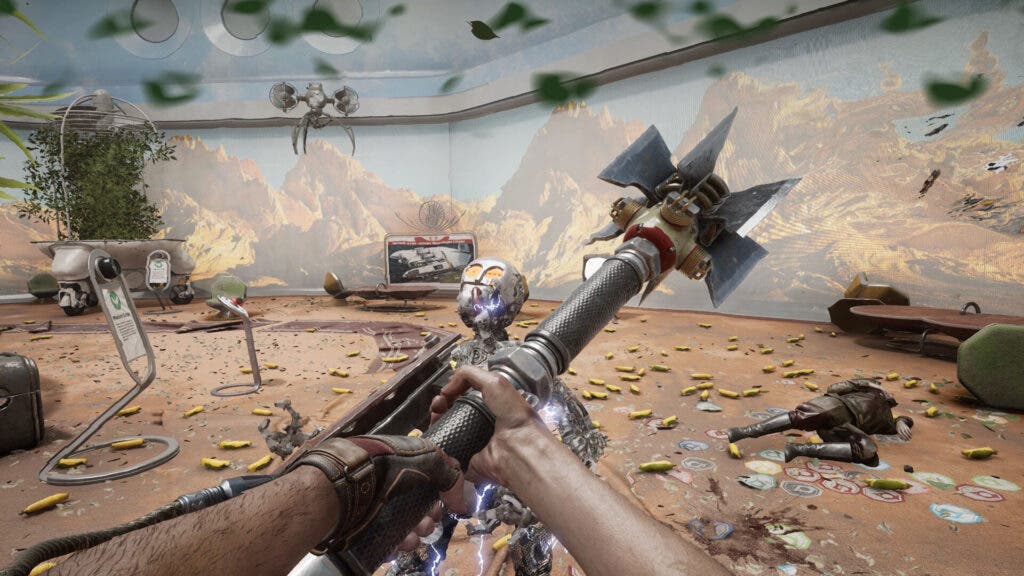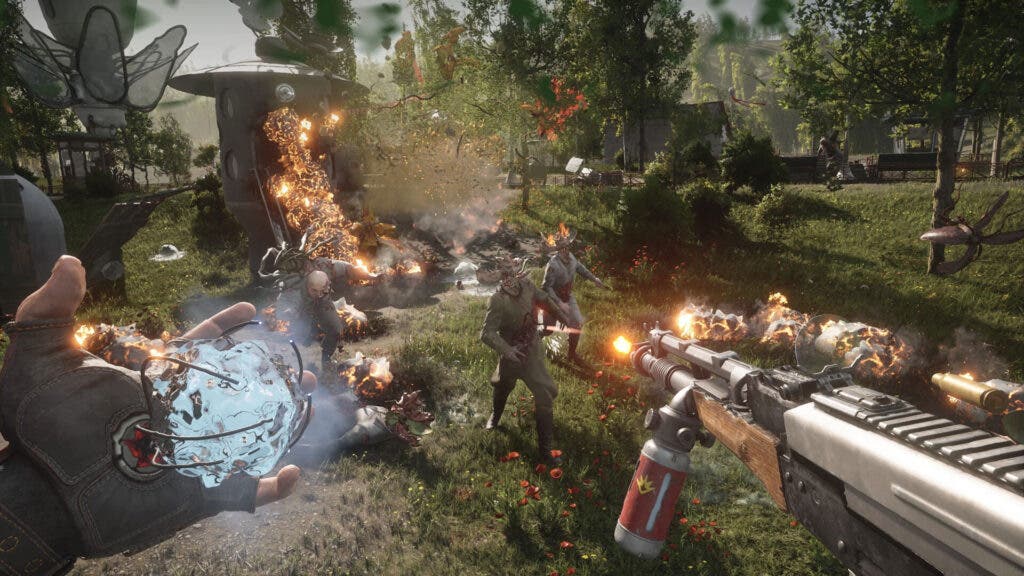Atomic Heart is a single-player first-person shooter that’s devoid of a battle pass and monetization, aside from some cosmetic DLCs you can purchase. Developer Mundfish certainly put a lot of heart and soul into this, as it seems to represent parts of their favorite games. Atomic Heart is not quite the “Russian BioShock ” it seemed it would be, and for the most part that’s a good thing, as they aren’t doing something so familiar. However, Mundfish’s first game fails to be more than a mish-mash of ideas that never truly solidifies into anything of substance.

Atomic Heart takes place in an alternate history 1955, located in the USSR. The Russians have been working hard to advance technology for the whole world, and have come with not only the first iteration of robotic life, but are on the cusp of releasing the second version with Kollective 2.0, a hive mind of robotic advancement. You play as Major Sergey Nechayev, or “P-3” as he is called through most of the game. It’s here you get to be part of the fall of a civilization, something akin to Half-Life while not being the direct cause. As you explore the city on your way to the first objective, these first generation robots have an off-putting look to them, with their sterile faces with no moving mouths, and wide open eyes that stare into your soul. P-3 is an absolute brain dead protagonist, which isn’t helped by his amnesia he sustained prior to the events, though he’s oblivious to what is so clear to everyone else – even your AI glove. Clearly there’s some translation gone awry as all the English text and voice work is wholly bizarre, with P-3 often exclaiming “Crispy critters!” – which seems to not only be an odd saying, but also just completely inappropriate in every way it gets said.
After things have gone to hell, you’ll quickly realize that this game is a bit of a looter shooter. You can hold ‘F’ to hoover up all the loot, which is a great quality of life feature for a game like this. Too many games make you interact with each and every element in order to pick everything up. This also has elements of action RPGs as well, with dialogue choices and optional quests to follow. The main quests suffer from them being nothing more than fetch quests, even long after the opening hours. There’s obstacle after obstacle after obstacle, where everything is drawn out and you have to follow too many steps to complete a simple objective. There are games that do this way, so that it doesn’t feel like a chore, but that’s not the case here. It’s an absolute momentum killer, and the game does it to you constantly, seemingly to pad out its length. It took me four hours just to leave the first area of the game and enter the open-world, and while I long for lengthy first-person shooters, and they can be great, this game doesn’t justify its length.

My favorite part of Atomic Heart is the combat, specifically the shooting, because the variety of Russian weaponry both realistic and fictional are just a joy to use. You’ve got AK-47s and PM pistols, and then there’s electricity guns and rocket launchers. It’s made even better when you’re upgrading weapons with new attachments, enhancements, and even simple things like adding more ammo capacity. You aren’t able to sprint for some reason in this game, but you are given a dash that can be upgraded into multiples to help dodge attacks that are telegraphed really well. There’s a reliance on melee weapons, from fire axes to machetes to parts from heavy machine, there’s a lot you can use to cut things up. What makes this unique is the system that surrounds it, as melee hits builds up an energy meter that you can use for your energy weapons.
To aid your shooting are the skills and powers you’ll unlock and be able to invest in. This is where a lot of the BioShock comparisons came in, as you’ll acquire powers like shock, ice, lift, and polymer. You can shock to stun enemies for either a melee strike or a firing of your gun. Similarly you can freeze a swarm of enemies to do damage before it wears off. There’s also a lift ability that can raise enemies in the air for easy shots, and an upgraded version slams them into the ground for a kill. All of your glove abilities are crowd control mechanisms, and you’re free to mix ‘n’ match them how you see fit. All upgrades spent can be refunded to invest in other areas, at any time, so it’s a really versatile system.

There are five laboratories and complexes to explore for high-tier weapons and attachments. At first it seemed to be just side objectives, but main story threads will be followed through all of these. So depending on your tolerance for things besides shooting, such as solving puzzles and even more asinine fetch quests await you.
It’s not much better once you have access to the open-world, it’s just an endless slog of enemies. This isn’t helped by the fact that the robots can be revived. They can be disabled, but only temporarily. I surmise this is so that there will also be resource drops for the player to use for crafting and upgrading, but there’s never a sense of progression in the open-world. Perhaps this is intended, but it’s completely frustrating as you constantly are swarmed by enemies. You do have options for travel through official transport like mag-levs and other official ways. There are cars that got left behind, but the driving physics are abysmal, and cars often explode after just a few hits. I even had instances where the vehicle completely flipped over as I got into it, making it undriveable from the get-go.

There’s lots of little things I enjoyed. As you play, there’s three lock types you’ll encounter, two of which felt really different: ones where you match colors, and a timing one where you snap your fingers when the light is on one you’ve not unlocked. The last one is a traditional lock-picking type as you rotate, but the sound isn’t great and on PC there’s no rumble feedback, so it’s pure guessing until it finally unlocks. I like how the robots incur battle damage as you shoot or thwack at them with melee.
There’s plentiful checkpoints in the game, but no manual saving, except for save stations that are strewn about. The substance that is meant to propel this society further, polymer, has some pleasant surprises. It’s a tool you can use in combat, and plenty of it was left behind in these odd tubes that you can “swim” through. As you do so, you’ll hear the memories of others – this helps remove a lot of loneliness in the game.

The sound mixing seems way off, as environmental effects of shooting and explosions don’t work with the music or voice lines, they feel and act like separate tracks. Thankfully, the music is terrific thanks to the work of Mick Gordon, as it’s very much the style of DOOM and Wolfenstein that you’d expect it to be, but with some surprising notes along the way.
Performance on the other hand, is excellent. Unreal Engine 4 is really putting in overtime here, the game just runs impeccably smooth, and looks brilliant at all times – even without DLSS enabled. Despite being touted for years, there’s no Ray Tracing enabled on the PC version. There’s also a disappointing lack of a FOV slider, which I had to edit manually for fear of getting motion sickness. Whether inside a facility or atop the floating complex, Atomic Heart is one of the most optimized games I’ve played in years.
My PC Specs:
– Microsoft Windows 11 Pro
– Intel Core i9 9900K @ 5Ghz (Turbo)
– Corsair H115i RGB PLATINUM 97 CFM Liquid CPU Cooler
– Corsair Vengeance RGB Pro 32 GB (2 x 16 GB) DDR4-3200 Memory
– EVGA GeForce RTX 3080 Ti 12GB GDDR6X FTW3 ULTRA
– Seagate FireCuda SSD (500GB)
– Seagate BarraCuda SSD (1TB + 2TB)
– OWC Aura P12 NVMe SSD (2TB)

Mundfish threw everything but the kitchen sink at this one, and I wish most of it worked for it. Atomic Heart is good when you’re using the various guns which have been upgraded to your liking, and you get the time to explore these gorgeous and detailed environments with strong artistic direction. What’s not so good is that the protagonist is completely unlikable, the writing is cringey, and the combat encounters are either completely exhausting or totally worthless to engage in. A first-person shooter where it’s better to not fight seems to be missing the point. Atomic Heart is certainly an ambitious, gorgeous, but ultimately disappointing and flat first-person shooter that I cannot recommend.
A Steam code was provided in advance by the publisher for review purposes
